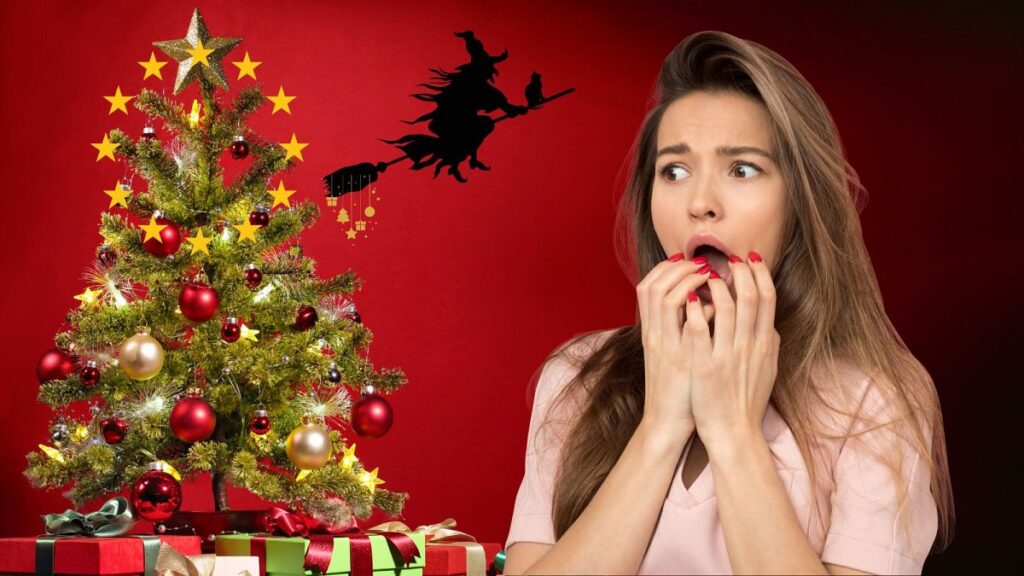While you’re overindulging in the festive cheer and the rampant commercial takeover of these holidays, keep these strange Christmas folklore figures in mind. Whether it’s the anti-Santa cat from Iceland or a child-chopping murderer from France, there’s plenty that’s bleak around the holidays.
You may have heard of the Grinch, the dastardly Yin to Santa’s benevolent Yang, but there are some strange Christmas traditions in Europe that might have slipped off your radar.
Here are five of our favourites. And by ‘favourites’, we mean nightmare-inducing and not overtly racist – so sorry Netherlands, no Zwarte Piet on this list.
We are however including a bonus silly one – for the cheer and all that.
Le Père Fouettard (France – Beligium – Switzerland)
Le Père Fouettard – literally ‘Father Whipper’ – is a cloaked and bearded character who acts as Saint Nicholas’ horrific enforcer.
Every 6 December, he delivers punishments to naughty children, usually in the form of lumps of coal and beatings. Plus, he loves noise, as his presence is usually accompanied by whips cracking, hooves scraping the ground and sounds of chains.
The tradition harks back to 1252, when an innkeeper captured three wealthy boys on their way to enroll in a religious boarding school. Wishing to rob them, he and his wife drugged, murdered and chopped up the scamps, letting them stew in a barrel.
Discovering this, Saint Nicholas resurrected the children and reassembled them.
Patron saint of children AND quite the wizard when it comes to thread and needle…
Saint Nicholas then cursed the innkeeper to an eternity of penance for the murders, twisting his body into a shadowy figure doomed to serve at his side. And thus was born le Père Fouettard.
The tale has its variations and plot holes, as punishing a killer of children by making him torture misbehaving kids for all eternity sounds a bit nonsensical and not very curse-like… Wouldn’t have been far easier to just prevent the poisoning and dismembering in the first place?
Since then, the tale has showed up in popular culture in films, books, and famously in Jacques Dutronc’s song ‘La Fille du père Noël’, which describes Père Fouettard’s son having a crush on Santa Claus’ daughter.
Befana the Witch (Italy)
In Italy, a broomstick-riding witch named Befana delivers sweets and presents to good children and punishes the bad ones.
Legend has it that the crone missed the birth of Jesus and has been doing the rounds on 5 January (Epiphany Eve) as penance ever since.
Harsh.
She is portrayed as having ember eyes, sharp teeth, a cutting tongue, and a sooty face – as she comes down from the chimneys to both treat and punish.
Many people believe that the name Befana is derived from the Italian version of the Greek word ‘epifania’ or ‘epiphaneia’, and effigies of her are burnt in order to mock her.
Again, harsh. All of this because she missed a birthday…
Krampus (Austria – Germany)
Half-goat, half-demon, this anthropomorphic terror is the counterpart to Saint Nicholas and the son of Hel, the Norse god of the underworld.
Krampus – whose name is taken from the German word for claw – shows up on 5 December, known as Krampusnacht. He beats children who are naughty and has even been known to kidnap them.
The Catholic church tried to ban him for his resemblance to the devil (spoilsports), and the Nazis even had a go, banning Krampus for its pagan origins.
To this day, there are still traditional parades celebrating Krampus – especially the Krampuslauf (Krampus run), in which people dressed as Krampus attempt to scare the younglings with their antics.
Krampus also got something of a cultural resurgence in TV, movies and video games. The character has featured in episodes of Scooby Doo and American Dad!; the 2015 horror film, Krampus, starring Adam Scott and Toni Collette (it’s not half bad) as well as a series of mediocre sequels / spinoffs like Krampus: The Reckoning, Krampus Unleashed, Krampus: The Devil Returns, and even Mother Krampus.
Jólakötturinn (Iceland)
In beautiful downtown Reykjavík on Lækjartorg square is a giant illuminated cat scultpture called Jólakötturinn.
So far, so delightful.
But this child-chomping Yule Cat has a dark backstory. As the tale goes, the giant feline eats children who don’t get new clothes for Christmas. It dates back to 1932, when Jóhannes úr Kötlum, an Icelandic poet, wrote about the Yule Cat in his book, “Jólin koma” (“Christmas is Coming”).
His poem describes a large puss with glowing eyes that roams the countryside, going from house to house looking for children to consume, should the scamps not be wearing the new clothes they got for Christmas. To avoid this fate, kids should do their chores in order to be deemed good enough to get new clothes – even if it is a modest pair of new socks – in order to remain amongst the living. Oh, and they should be thankful for the gifts they receive.
Over time, it became a morality tale that states that we should all help each other in the spirit of the season, not forget the luxuries we might be taking for granted, and help those less fortunate with small but vital gestures. Otherwise, it’s a massacre courtesy of Hannibal Lickter.
The Kallikantzaroi (Greece – Bulgaria – Serbia)
The Kallikantzaroi are hairy little goblins who live underground for most of the year, where they attempt to bring about the apocalypse by sawing down the ‘World Tree’ – or ‘Yggdrasil’ in Norse mythology.
Nefarious, but everyone needs a hobby.
For Christmas day and the following twelve nights, the goblins are allowed to roam the earth where they attempt to gain entry to people’s houses and play pranks on them.
So, how best to avoid finding goblin shit in your bed or a rearranged home?
Well, tradition states that you should hang a pig jaw bone in the door frame.
Alternatively, put a colander on the doorstep – it’ll distract the Kallikantzaroi as they stop to count the holes. Apparently, they can only count to two, so that will keep them busy for the twelve nights before they are sent back to a healed World Tree and begin their fruitless endeavour to hack its trunk for another year.
And here’s the bonus silly one…
The Catalan log that shits out sweets and presents
The “Caga Tió” or “Tió de Nadal” is a wooden log decorated with a face that is fed treats throughout December. Then, on Christmas Eve, children beat the log with sticks and sing traditional songs to coax it into shitting out sweets and gifts.
One of the songs goes like this: Caga tió (Poop log) / Tió de Nadal (Log of Christmas) / No caguis arengades (Don’t poop salted herring) / Que són massa salads (They are too salty) / Caga torrons (Poop turróns) / Que són més bons! (They are much better)
As strange as this all sounds, it’s hardly surprising.
Wander around the Christmas markets in Catalonia and you’ll end up stumbling across a “Caganer”, a bare-bottomed pooping figurine wearing a traditional Catalan barrentina red cap. The Caganer (Catalan for “pooper”) figure traditionally depicts a squatting peasant with his trousers dropped to reveal a bare backside. At Christmas, the miniature figures are placed alongside Mary, Joseph and baby Jesus.
Faeces and defecation are common in Catalan folklore, including the popular Catalan phrase usually said before a meal: “Menja bé, caga fort i no tinguis por a la mort!”, which translates as “Eat well, shit strong, and don’t be afraid of death!”.
The cheeky tradition isn’t meant to be blasphemous, but rather a source of luck and prosperity for the new year. One theory suggests that the caganer represents fertility and the fertilization of the earth, thereby being a symbol of a prosperity and good health.
And it turns out that Europe loves a pooper, as the Caganer is not the only defecating character you can find. In Italy, specifically near the Naples area, you can stumble across “Cacone” or “Pastore che caca”, a similar figure to the Caganer. Also placed in the Neapolitan nativity scene, it is a symbol of good luck and the miracle of birth. Similarly, the French have “Père la Colique” and the Portuguese have “Cagões”, a pooper who serves as a levelling device to bring the mighty down.


